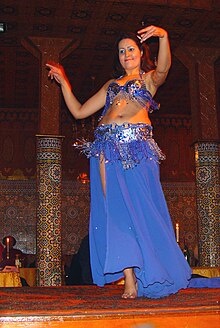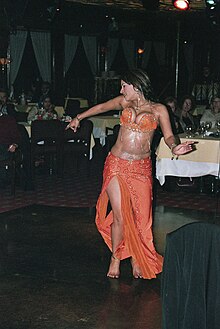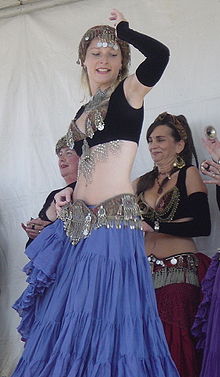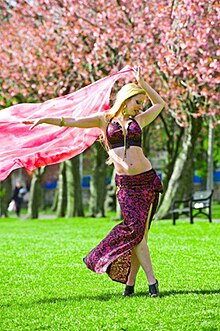Belly dance: Difference between revisions
Ohnoitsjamie (talk | contribs) source please |
|||
| Line 23: | Line 23: | ||
===Costume in Egypt=== |
===Costume in Egypt=== |
||
A separate decorative top shaped like a bra (sometimes a bra) and skirt are worn, a belt is rarely used and any embellishment is embroidered directly on the tight, worn under the skirt covering the skin. A dancer has to cover her [[navel|belly button]] by law especially during times when Egypt had strict regulations regarding modesty. A Brooch is optional. Dancers would be required to wear a body or stomach stocking to cover the entire stomach area, by law. A navel ring or brooch was a way to add an additional touch to the costume, underneath. Egyptian dancers traditionally dance in bare feet, but these days often wear high heels or flats or high heels. |
|||
===Costume in Lebanon=== |
===Costume in Lebanon=== |
||
Revision as of 20:42, 4 January 2013

This article needs additional citations for verification. (September 2010) |
Belly dance or bellydance is a Western-coined name for a "traditional West Asian" dance, especially raqs sharqi (Arabic: رقص شرقي). It is sometimes also called Middle Eastern dance or Arabic dance in the West.
The term "belly dance" is a translation of the French "danse du ventre" which was applied to the dance in the Victorian era. It is something of a misnomer as every part of the body is involved in the dance; the most featured body part is usually the hips. Belly dance takes many different forms depending on the country and region, both in costume and dance style, and new styles have evolved in the West as its popularity has spread globally. Although contemporary forms of the dance have generally been performed by women, some of the dances, particularly the cane dance, have origins in male forms of performance.
- Raqs sharqi (Arabic: رقص شرقي; literally "eastern/oriental dancing") is the style more familiar to Westerners, performed in restaurants and cabarets around the world. It is more commonly performed by female dancers but is also sometimes danced by men. It is a solo improvisational dance, although students often perform choreographed dances in a group.
- Raqs baladi, (Arabic: رقص بلدي; literally "local dancing", or "folk" dance) is the folkloric style, danced socially by men and women of all ages in some Middle Eastern countries, usually at festive occasions such as weddings. However, this naming is used synonymously in Egypt with Raqs sharqi as a generic term for "belly dancing".
Belly dance was popularized in the West during the Romantic movement of the 18th and 19th centuries, when Orientalist artists depicted romanticized images of harem life in the Ottoman Empire. Around this time, dancers from Middle Eastern countries began to perform at various World's Fairs, often drawing crowds in numbers that rivaled those for the science and technology exhibits. It was during this period that the term "oriental" or "eastern" dancing was first used. Several dancers, including the French author Colette, engaged in "oriental" dance, sometimes passing off their own interpretations as authentic.
Costume
The bedlah style includes a fitted top or bra (usually with a fringe of beads or coins), a fitted hip belt (again with a fringe of beads or coins), and a skirt or harem pants. The bra and belt may be richly decorated with beads, sequins, braid and embroidery. The belt may be a separate piece, or sewn into a skirt.
Badia Masabni, a Cairo cabaret owner, is credited with bringing the costume to Egypt, because it was the image that Western tourists wanted.
The hip belt is a broad piece of fabric worn low on the hips. It may have straight edge, or may be curved or angled. The bra usually matches the belt and does not resemble lingerie. The classic harem pants are full and gathered at the ankle, but there are many variations. Sometimes pants and a sheer skirt are worn together. Skirts may be flowing creations made of multiple layers of one color sheer fabric chiffon.
Costume in Egypt
A separate decorative top shaped like a bra (sometimes a bra) and skirt are worn, a belt is rarely used and any embellishment is embroidered directly on the tight, worn under the skirt covering the skin. A dancer has to cover her belly button by law especially during times when Egypt had strict regulations regarding modesty. A Brooch is optional. Dancers would be required to wear a body or stomach stocking to cover the entire stomach area, by law. A navel ring or brooch was a way to add an additional touch to the costume, underneath. Egyptian dancers traditionally dance in bare feet, but these days often wear high heels or flats or high heels.
Costume in Lebanon
As there is no prohibition on showing the stomach in Lebanon, the bedleh style is more common. The skirts tend to be sheer and/or skimpier than Egyptian outfits, showing more of the dancer's body. The veil is more widely used and the veil matches the outfit. High heels are commonly worn.
Costume in Turkey
Turkish dancers also wear bedleh style costumes. In the 1980s and '90s a costume style developed with skirts designed to display both legs up to the hip, and plunging bras. Such styles still exist in some venues but there are also many Turkish belly dancers who wear more moderate costumes. Even so, many Turkish belly dance costumes reflect the playful, flirty style of Turkish belly dance.
Steps and technique
Most of the movements in belly dancing involve isolating different parts of the body (hips, shoulders, chest, stomach, etc.), which appear similar to the isolations used in jazz ballet, but are often driven differently. Correct posture and muscle control is as important in belly dance as it is in other fields of dance.[1]
In most belly dance styles, the focus is on the hip and pelvic area. Due to the diversity of styles and 'origins' of the dance, many of the moves are referred to by a wide variety of different terminologies. However, from an observer's point of view bellydance includes certain key elements.
Important moves are:
- Shiver or Shimmy – a shimmering vibration of the hips. This vibration is usually layered onto other movements to create depth in performance. The simplest shimmy is created by moving the knees past each other at high speed, but contractions of the glutes, thighs or lower back may be used instead to create different qualities of movement. The shimmy can be performed in different directions - up and down, side-to-side, or in a forward and back swinging motion. The same move can be performed using the chest and shoulders, sometimes called a shoulder shimmy.
- Hip hits – A staccato movement of the hips out from the body. This can also be performed using other body parts such as the shoulders or chest. The move is usually achieved by isolating the hip area and contracting the glute muscles to move the hips up or down. The dancer's weight can either be distributed across both legs or on one leg with the toes of the other foot pointed.
- Undulations – Fluid movements of the hips or of the chest and abdominal muscles in a circular or rotating fashion. There are a wide variety of movements of this kind, of which the most well known is probably the rotating movements of the chest forward, up, back and down to create the impression of riding a camel.
Different styles also incorporate kicks and arm movements as an integral part of the style.
Egyptian belly dance
In Egypt, three main forms of the traditional dance are associated with belly dance which are called by different terms. Broadly, these are cabaret dance, folk dance, and classical dance. The terms often used are: Sha'abi, Baladi/Beledi, and Sharqi.

Baladi is a folk style of dance from the Arab tribes who settled in Upper Egypt. However the term has come to refer to the folk dances performed by the working classes of urbanised Egypt. Dance which tries to preserve folk traditions from the countryside or from specific tribes is often referred to as Ghawahzee. Ghawahzee dancers have also been known to be at the heart of the conflict in Egypt over the propriety of publicly performed dance. The well-reputed Mazin sisters are widely held to be the last authentic performers of Ghawahzee dance. Khayreyya Mazin is currently the last of these dancers still teaching and performing as of 2009.[2]
For a detailed explanation of the Sharqi style, see the main entry for Raqs Sharqi.
Turkish belly dance
Some mistakenly believe that Turkish oriental dancing is called Çiftetelli because this style of music has been incorporated into oriental dancing by Arabs. However, Turkish Çiftetelli is actually a form of lively wedding music and is not connected with oriental dancing. Turkish belly dance today may have been influenced by Arabs before the Ottoman Empire as much as by the Egyptian and Syrian/Lebanese forms. Turkish law does not impose restrictions on dancers as they do in Egypt, where dancers must keep their midriffs covered and cannot perform floor work and certain pelvic movements. This has resulted in a marked difference in style - Egyptian bellydance is noted for its restraint and elegance, whereas Turkish bellydance is playful and uninhibited. Many professional dancers and musicians in Turkey continue to be of Romani heritage, which is the great part of a varied fusion in this dance. (There is also a distinct Turkish Romani dance style which is different from Turkish Oriental.) Turkish dancers are known for their energetic, athletic (even gymnastic) style, and their adept use of finger cymbals, also known as zils. Connoisseurs of Turkish dance often say a dancer who cannot play the zills is not an accomplished dancer. Another distinguishing element of Turkish style is the use of the Karsilama rhythm in a 9/8 time signature, counted as 12-34-56-789. Famous Turkish belly dancers include Tulay Karaca, Nesrin Topkapi and Birgul Berai and Didem
Belly dance in the West
Belly dance in the USA

The term "belly dancing" is generally credited to Sol Bloom, entertainment director of the 1893 World's Fair, the World Columbian Exposition in Chicago, although he consistently referred to the dance as "danse du ventre," of which "belly dance" is a literal translation. In his memoirs, Bloom states only that "when the public learned...danse du ventre...I had a gold mine."
Although there were dancers of this type at the 1876 Centennial in Philadelphia, it was not until the Chicago World's Fair that it gained national attention. There were authentic dancers from several Middle Eastern and North African countries, including Syria, Turkey and Algeria, but it was the dancers in the Egyptian Theater of The Street in the Cairo exhibit who gained the most notoriety. The fact that the dancers were uncorseted and gyrated their hips was shocking to Victorian sensibilities. There were no soloists, but it is claimed that a dancer nicknamed Little Egypt stole the show. Some claim the dancer was Farida Mazar Spyropoulos, but this fact is disputed.[3]
The popularity of these dancers subsequently spawned dozens of imitators, many of whom claimed to be from the original troupe. Victorian society continued to be affronted by this "shocking" dance, and dancers were sometimes arrested and fined.[4] The dance was nicknamed the "Hootchy-Kootchy" or "Hoochee-Coochie", or the shimmy and shake. A short film, "Fatima's Dance", was widely distributed in the nickelodeon (movie theater)s. It drew criticism for its "immodest" dancing, and was eventually censored. Belly dance drew men in droves to burlesque theaters, and to carnival and circus lots.
Thomas Edison made several films of dancers in the 1890s. These included a Turkish dance, and Crissie Sheridan in 1897, and Princess Rajah from 1904, which features a dancer playing zills, doing "floor work", and balancing a chair in her teeth.
Ruth St. Denis also used Middle Eastern-inspired dance in D.W. Griffith's silent film Intolerance, her goal being to lift dance to a respectable art form at a time when dancers were considered to be women of loose morals. Hollywood began producing films such as The Sheik, Cleopatra, and Salomé, to capitalize on Western fantasies of the orient.
When immigrants from Arab States began to arrive in New York in the 1930s, dancers started to perform in nightclubs and restaurants.
In the late 1960s and early '70s many dancers began teaching. Middle Eastern or Eastern bands took dancers with them on tour, which helped spark interest in the dance.
Although using traditional Turkish and Egyptian movements, American Cabaret or American Restaurant belly dancing has developed its own distinctive style, using props and encouraging audience interaction. Many modern practitioners make use of the music of Egyptian Sha'abi singers, including Ahmed Adaweya, Hakim, and Saad el Soghayar in their routines, which combines the percussion of modern Egyptian music with a traditional feeling for music and dance in the Raks Sha'abi (dance of the people) style.
In 1987, a uniquely American style, American Tribal Style Belly Dance, (ATS), was created. Although a unique and wholly modern style, its steps are based on a melting pot of ancient dance techniques including those from North India, the Middle East, and Africa.
Many forms of "Tribal Fusion" belly dance have also developed, incorporating elements from many other dance and music styles including flamenco, ballet, burlesque, hula hoop and even hip hop. "Gothic Belly Dance" is a style which incorporates elements from Goth subculture. Tribal style dance is characterized by muscle isolation to create smooth, undulating movements; it also tends to feature small, somewhat mincing movements, unlike the more sweeping movements of the traditional dance. Like other forms of belly dance, Tribal dance is more accessible than many other dance styles to people with a wider range of body types, ages, and health problems.
Belly dance in Australia
The first wave of interest for belly dancing in Australia was during the late 1970s to 1980s with the influx of migrants and refugees escaping troubles in the Middle East, including drummer Jamal Zraika. These immigrants created a lively social scene including numerous Lebanese and Turkish restaurants, providing employment for belly dancers.
Early dance pioneers included Amera Eid and Terezka Drnzik. Both of these teachers have pedigrees linked back to Rozeta Ahalyea. Belly dance has now spread across the country, with vibrant belly dance communities in every capital city and many regional centres.
see also Academy of middle eastern dance ( AMED)
Belly dance in Canada

Canada has a belly dance community similar to United States of America.
Belly Dance in the United Kingdom

Belly Dance culture has been in evidence in the UK since the early 1960s. The majority of activity occurred in London, with a few regional exceptions. During the 1980s a new expertise started to appear in the form of the Belly Dancer teacher. Pioneered by the importation of American Belly Dance talent, new British talent attempted to establish a distinctive British flavour in the class room.
It is true that UK Belly Dancers have been greatly influenced by the US Belly Dance scene. Initially the AmCab importation in the 1970s and 1980s and then American Tribal Style Belly Dance fusion styles of the 1990s, and more recently the popular BDSS modern American style (with its Suhaila Salimpour technique) in the 2000s have influenced the British scene.
There have been and continues to be cross-over explorations of the burlesque-belly dance hybrids. And there is an interest in the form a specific British Tribal Style which has explored social dance links with Morris Dancing and Steam Punk etc.
A split has occurred between the Fusionist and non-Fusionist camp. The Fusionist bring to light the need to consider the "cultural" specificity of the UK performance context which differs from an Egyptian one. The non-Fusionist's position concerns the notion that a cultural form of dance needs to stand true to its country of origin, specifically when the "music", which arguably forms of the context for the dancing in whatever cultural location, is Middle Eastern in origin. The debate continues.
In addition, tours of Egypt, Tunisia, and more recently Morocco have also become a major feature of the Belly Dance scene in the UK. This has brought into sharp relief the cultural and aesthetic traditions and knowledge omitted by previous practitioners.
JWAAD, The Raqs Sharqi Society, Hossam Ramzy and other groups and individuals have developed "teacher training" for Belly Dancers. During recent interest in Belly Dance the arrival of the "Egyptian" male Belly Dancer has brought a new gender-specific political tension to the UK scene. Middle Eastern and male Belly Dancers/Folk dancers have gained economic and cultural ground within a short space of time. It remains that the British Belly Dance community of shared Belly Dance practice is far from being a cohesive market with practitioners sharing common goals and interests. British Belly Dance has a long history of contested identities, authority and creative vision which you could argue provides for a rich tapestry of different forms of Belly Dance in the British Isles.
Belly dance in Asia
Asia now has belly dancing competitions, like the Asia Global Belly Dance Competition.
Health and belly dancing
Belly dance is a non-impact, weight-bearing exercise and is thus suitable for all ages[5]. Belly Dancing for Fitness It is a good exercise for the prevention of osteoporosis in older people. Many of the moves involve isolations, which improves flexibility of the torso. Belly dance moves are beneficial to the spine, as the full-body undulation moves lengthens (decompress) and strengthens the entire column of spinal and abdominal muscles in a gentle way.
Dancing with a veil can help build strength in the upper body, arm and shoulders. Playing the zills trains fingers to work independently and builds strength. The legs and long muscles of the back are strengthened by hip movements.[6]
Paffrath researched the effect of belly dance on women with menstruation problems. The subjects reported a more positive approach toward their menstruation, sexuality, and bodies.
Beginning in the late 1990s, belly dance hit the mainstream marketplace and with fitness videos/DVDs by such artists as Veena and Neena, Rania Bossonis, and Dolphina. These videos are still popular throughout the world and have been credited with opening a new market of belly dance fitness classes throughout the US and abroad.
Notable practitioners
People known primarily for belly dancing include:
Belly dancing in pop culture
Belly dancing has recently been repopularized by Latin American superstar Shakira. She is Colombian and Lebanese, which has influenced her style. She has put a modern spin on the art whilst still using traditional moves; some of her routines incorporate Zumba or Latin American styles. Videos of hers that belly dance is used in include "Whenever, Wherever," "Hips Don't Lie," "She Wolf," "Ojos Así," "Beautiful Liar," "Waka Waka (This Time for Africa)," "Loca" and "Gypsy."
The Brazilian novella O Clone (also known as El Clon in Spanish-speaking countries and the United States) is set in Brazil and Morocco and featured belly dancing in many episodes. The lead character, Jade (Giovanna Antonelli), used it to entice her lover Lucas (Murilo Benício) and to soothe and seduce her husband Said (Dalton Vigh).
Several James Bond films have featured belly dancers. In The Man With the Golden Gun, the belly dancer Saida wears a spent bullet in her navel, which Bond accidentally swallows while trying to retrieve it.
In the Beatles' movie Help! there is a restaurant scene which Paul McCartney enters with the other Beatles and attempts conversation with a belly dancer.
R&B singer Aaliyah used the belly roll as her signature move. Other singers and actresses who have performed belly dance moves include Britney Spears, Christina Aguilera, Yvonne De Carlo, Jessica Simpson, Beyoncé, Ciara, and Hilary Duff.
Probably the most famous belly dance troupe is the group formed by Miles Copeland III: Bellydance Superstars tours internationally, furthering the popularity of bellydance around the world by performing over 700 shows in over 22 countries. Gravitating from small theatres and clubs the troupe now performs in much the same venues as Riverdance and other mainstream dance shows. The shows have made stars of several of its dancers, including Rachel Brice, Jillina, Sonia, Petite Jamilla, and Kami Liddle.
Documentaries about belly dance include American Bellydancer, Belly, and Temptation of Bellydance.
Today bellydance itself has become an industry. It includes numerous weekly classes around the world. The most popular classes take place in Egypt at the Ahlan WaSahlan annual festival. There are also courses that can be taken via the Nile Group in Egypt. This group featured one of the world's top male raqs artists, Tito Seif.
The bellydance costume industry is also very large. There are many other suppliers and costumers found at the many festivals. Khan al Khalili is the world's most popular spot for bellydance wear/Raqswear and continues to attract millions of visitors every year.
See also
References
- ^ http://www.youtube.com/watch?v=C5_wfnntunw&feature=share
- ^ , Gilded Serpent "The Ghawazee: Back from the Brink of Extinction"
- ^ Donna Carlton (1995) Looking for Little Egypt. Bloomington, Indiana: International Dance Discovery Books. ISBN 0-9623998-1-7.
- ^ "New York Times, Dec 7 1893"
- ^ Dallal, Tamalyn (2004). Belly Dancing For Fitness. Berkley: Ulysses Press.
- ^ Coluccia, Pina, Anette Paffrath, and Jean Putz. Belly Dancing: The Sensual Art of Energy and Spirit. Rochester, Vt: Park Street Press, 2005
